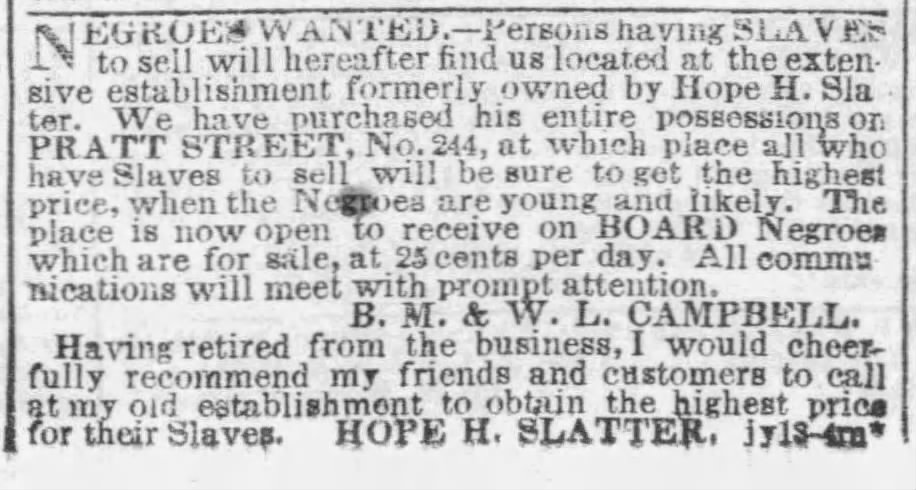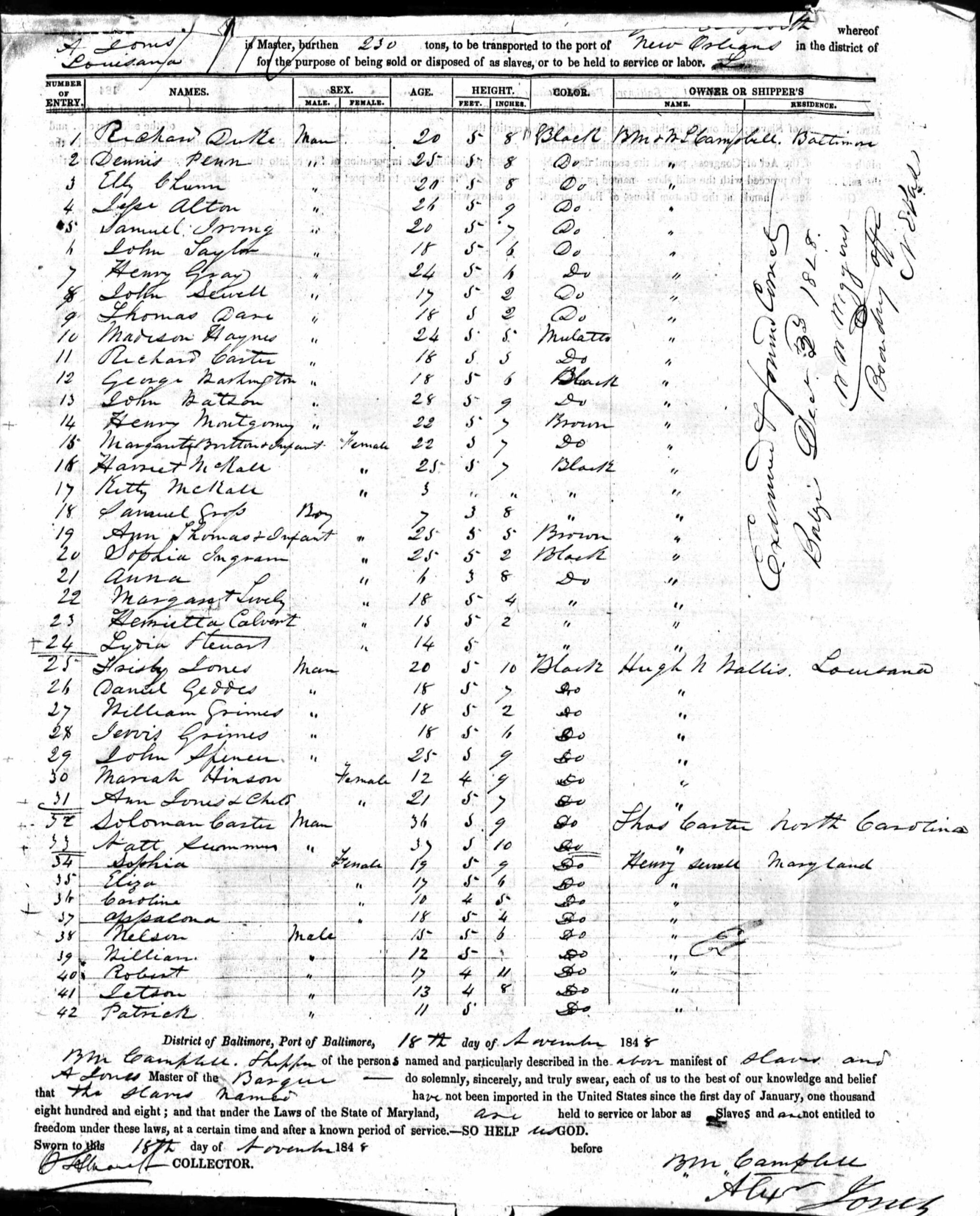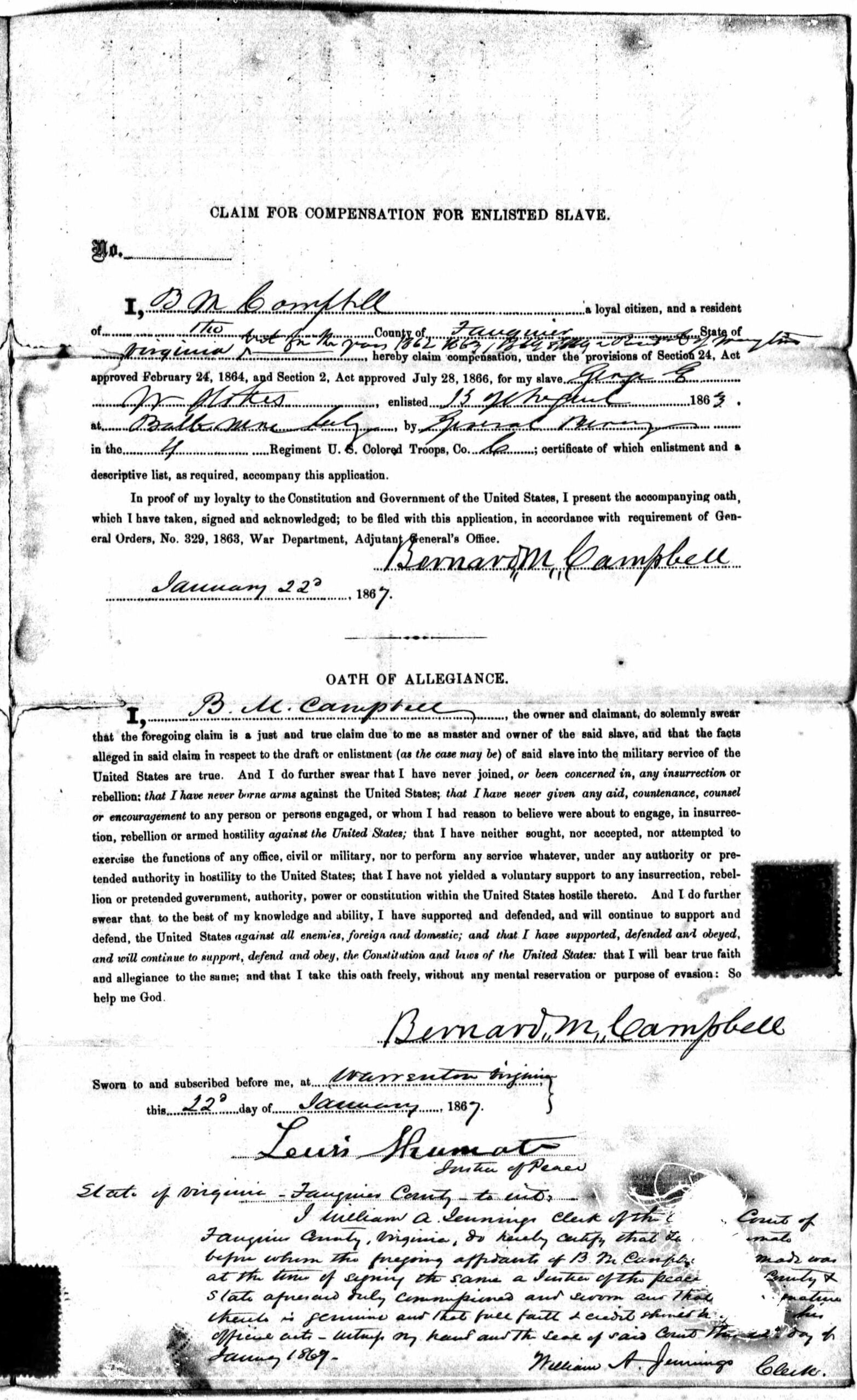
 Bernard M. Campbell, one of Baltimore’s most notorious traders of enslaved African Americans, owned both land and enslaved individuals in Carroll County according to county records from the 1850s and 1860s.
Bernard M. Campbell, one of Baltimore’s most notorious traders of enslaved African Americans, owned both land and enslaved individuals in Carroll County according to county records from the 1850s and 1860s.
In 1848, Campbell and his brother Walter purchased the slave-trading operation of Hope H. Slatter on Pratt Street along Baltimore’s harbor and continued Slatter’s practice of buying and selling enslaved persons. Over the next 15 years, Bernard M. Campbell (often noted as B. M. Campbell) became one of the nation’s largest slave dealers, sending men, women, and children purchased in Maryland for resale in New Orleans and other southern cities. Between April 1851 and November 1852 alone, ship manifests show they transported 339 enslaved people from Baltimore.
Bernard M. Campbell and his family apparently lived in Baltimore City. In the 1850 U.S. Census for Baltimore City, “B M Campbell,” aged 36, shared his home with “J C Campbell,” aged 23, probably a brother. They were both born in Georgia and were each listed as a “Slave Dealer.” Bernard Campbell held 35 enslaved people in 1850, according to the census record. By 1860, Campbell had a wife and one young child. He gave his age as 50, with no occupation listed, and a personal property value of $100,000. Much of that value likely derived from enslaved people. The Slave Schedule of the 1860 census listed 50 men, women, children, and several infants under the name of Bernard Campbell.
In 1858, Campbell purchased 307 acres in a rural part of Carroll County. Although there is no indication he lived on the property, an advertisement placed by Campbell in the March 11, 1859, Baltimore Sun offered a $100 reward for Henry Philips “who left my farm on the 10th, near Marriottsville, Carroll co.” This confirms that Campbell kept at least one enslaved person on his Carroll County farm. Land record research by Jeff Duvall shows that Campbell’s property lay near Liberty Road, a major route to Baltimore from the southeastern part of the county, ironically called the Freedom District. However, the 1860 census records for Carroll County do not show B.M. Campbell as a resident or slaveholder in the county.
 The Carroll County tax records provide a clue to the purpose of Campbell’s Freedom District farm. In 1862, in addition to paying taxes on his land, a second entry indicated he also owed taxes on “18 negros @ $200 each. . .$3600.” Transactions involving buying or selling enslaved people in Carroll County records usually named each individual and assigned him or her a specific value. This entry implies Campbell’s “negros” were nameless and of the same value regardless of their age or sex, indicating Campbell dealt in large numbers of enslaved people. These 18 enslaved individuals were likely part of Campbell’s Baltimore slave trade, kept temporarily on his county farm prior to resale.
The Carroll County tax records provide a clue to the purpose of Campbell’s Freedom District farm. In 1862, in addition to paying taxes on his land, a second entry indicated he also owed taxes on “18 negros @ $200 each. . .$3600.” Transactions involving buying or selling enslaved people in Carroll County records usually named each individual and assigned him or her a specific value. This entry implies Campbell’s “negros” were nameless and of the same value regardless of their age or sex, indicating Campbell dealt in large numbers of enslaved people. These 18 enslaved individuals were likely part of Campbell’s Baltimore slave trade, kept temporarily on his county farm prior to resale.
 B.M. Campbell’s name also appears in the chattel and bond records of Carroll County for manumissions of two enslaved men, Robinson Sewell and George E.W. Stokes, recorded in 1864. Given that both men’s manumission documents were recorded in Carroll County, it is likely that both were living enslaved on Campbell’s Freedom District farm at the time of their enlistments. Sewell and Stokes both enlisted in Baltimore in the 4th Regiment of the United States Colored Troops during the summer of 1863. Campbell was required to manumit (free) both men as a result of their military service according to General Order No. 329, issued on October 3, 1863. In 1867, Campbell, then living in Virginia, applied “for compensation for service of a slave” from the federal government for the military service of both Sewell and Stokes, though it is unknown if he was successful.
B.M. Campbell’s name also appears in the chattel and bond records of Carroll County for manumissions of two enslaved men, Robinson Sewell and George E.W. Stokes, recorded in 1864. Given that both men’s manumission documents were recorded in Carroll County, it is likely that both were living enslaved on Campbell’s Freedom District farm at the time of their enlistments. Sewell and Stokes both enlisted in Baltimore in the 4th Regiment of the United States Colored Troops during the summer of 1863. Campbell was required to manumit (free) both men as a result of their military service according to General Order No. 329, issued on October 3, 1863. In 1867, Campbell, then living in Virginia, applied “for compensation for service of a slave” from the federal government for the military service of both Sewell and Stokes, though it is unknown if he was successful.
In July 1863, several weeks after the Battle of Gettysburg, Colonel Wm. Birney and other US Army personnel, liberated the individuals in Campbell’s slave pen on Pratt Street – 26 men, one boy, 29 women and three infants. An article in The Philadelphia Inquirer on July 31, 1863, described the inhumane living conditions in the compound. (see “Letters, Diaries, and Memoirs” database for Col. Birney’s report on what he found in what he called “Camlin’s Slave Pen,” reprinted in The Philadelphia Inquirer in July 1863.)
Bernard Campbell and his wife Emily were apparently living on their Carroll County farm in April 1864 when they sold their land to a nearby landowner and enslaver, James F. Purvis. Campbell does not appear in Carroll County records after Maryland abolished slavery on November 1, 1864 by a change in the state constitution. As noted previously, by 1867, he was living in Virginia (Fauquier County).
The purpose of Bernard M. Campbell’s 300+ acre farm in Carroll County, which existed between 1858 and 1864, invites speculation. It likely included accommodations for enslaved persons in addition to farm managers. Living conditions would have been far healthier in the country than in a slave jail in Baltimore, and Campbell would reap higher profits from selling healthy bondsmen in New Orleans. Crops and livestock raised on the farm were likely used to feed Campbell’s enslaved people held in Baltimore as well as in Carroll County. One of Campbell’s newspaper advertisements noted that slaves could be “boarded” for 25 cents per day. (See Image 1) Moving people as well as farm produce between Carroll County and Baltimore would have been easy.
Campbell’s slave trading operations in both Carroll County and Baltimore City deserve further investigation.



